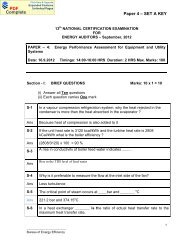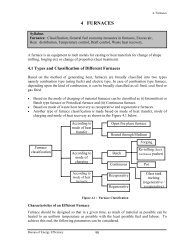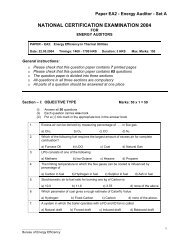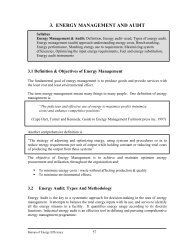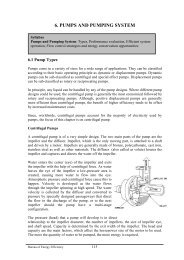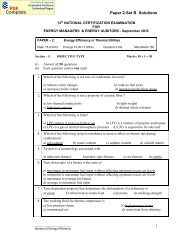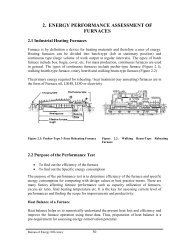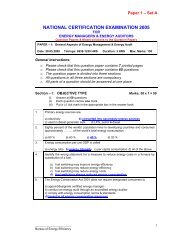13. WASTE MINIMISATION AND RESOURCE CONSERVATION
13. WASTE MINIMISATION AND RESOURCE CONSERVATION
13. WASTE MINIMISATION AND RESOURCE CONSERVATION
You also want an ePaper? Increase the reach of your titles
YUMPU automatically turns print PDFs into web optimized ePapers that Google loves.
<strong>13.</strong> Waste Minimisation and Resource Conservation<br />
A typical checklist for technical evaluation could be as follows:<br />
‣ Availability of equipment<br />
‣ Availability of operating skills<br />
‣ Space availability<br />
‣ Effect on production<br />
‣ Effect on product quality<br />
‣ Safety aspects<br />
‣ Maintenance requirements<br />
‣ Effect on operational flexibility<br />
‣ Shut down requirements for implementation<br />
Assess Economic Viability<br />
Economic viability would often be the key parameter to promote or discourage Waste<br />
Minimisation. For a smooth take-off, it is therefore essential that the first few Waste<br />
Minimisation measures should be economically very attractive. Such a strategy helps in<br />
creating more interest and sustains commitment.<br />
Options requiring little investment, but involving more of procedural changes (housekeeping<br />
measures, measures, operational improvements) do not need an intensive economic analysis<br />
and simple methods like pay back period could be used. However as Waste Minimisation<br />
measures become more involved and capital intensive, other profitability analysis methods<br />
viz. Return on Investment (IRR) or Net Present Value (NPV) are recommended to get the<br />
total picture.<br />
While doing the economic investment, the costs may include fixed capital i.e. cost of<br />
equipment, working capital cost, shutdown cost, O & M costs etc. The savings could be<br />
direct savings of input materials / energy, increased production levels and hence lower<br />
specific input cost, lower O & M cost, value of by products, reduction in environmental cost<br />
i.e. waste treatment transportation and disposal cost etc.<br />
Evaluate Environmental Aspects<br />
The options for Waste Minimisation with respect to their impact on the environment should<br />
be assessed. In many cases the environmental advantage will be obvious if there is a net<br />
reduction in the toxicity and / or quantity of waste. Other impacts could be changes in<br />
treatment of the wastes. In the initial stages, environmental aspects may not appear to be as<br />
compelling as economic aspects. In future as in developed countries, environmental aspects<br />
would become the most important criteria irrespective of the economic viability.<br />
Select Solutions for Implementation<br />
After technical, economic and environmental assessment, Waste Minimisation measures<br />
should be selected for implementation. Understandably, the most attractive ones would be<br />
those having best financial benefits, provided technical feasibility is favourable. However, in<br />
a growing number of cases especially when active pressure groups are present,<br />
environmental priorities may become the final deciding factor.<br />
Bureau of Energy Efficiency 171



